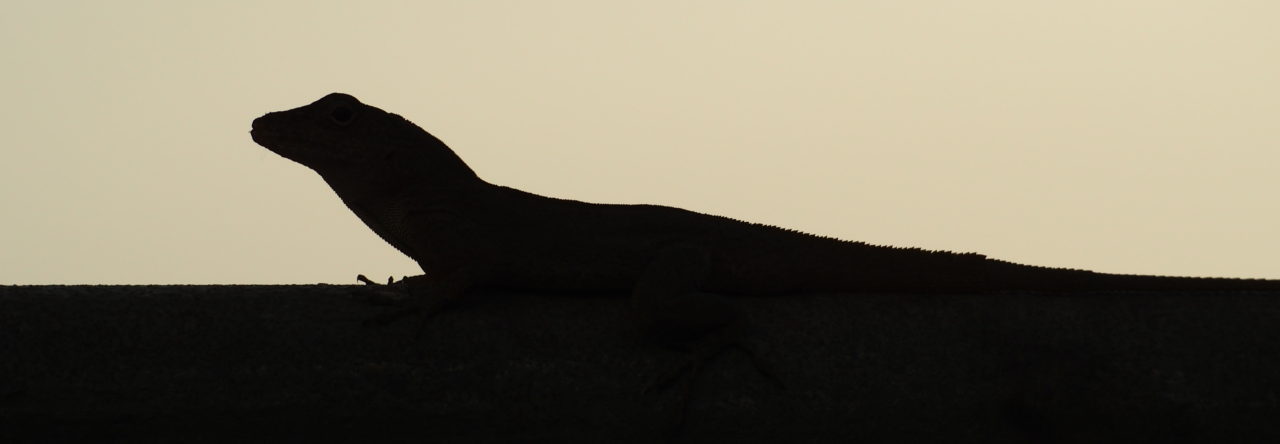Although many generic names have been proposed for species within the anole clade, traditionally only three other than Anolis were widely used: Chamaeleolis, Chamaelinorops and Phenacosaurus. Each of these clades—which at one time were thought to represent early, pre-Anolis derivations from the anoline line—are morphologically distinctive. The former two, Chamaeleolis and Chamaelinorops, need no introduction—they are oddball species that at first pass might not even be recognized as anoles, and that have received a modicum of scientific study. The third clade, Phenacosaurus, by contrast, has been mostly ignored. This is surprising, because at least some species are quite notable morphologically, with head casques, heterogeneous scalation, wild colors, and an all-over prehistoric appearance. Moreover, they live at remarkably high altitudes, at least by anole standards, and have a passing resemblance—some species more than others—to Caribbean twig anoles. Nonetheless, there is almost no literature on the natural history or evolution of these anoles.
Ken Miyata’s 1983 Journal of Herpetology paper is the one exception. In it, he describes the habitat use of A. heterodermus in areas near Bogotá, Colombia. His description paints the species as one that uses narrow perches on bushes and other vegetation, and that is especially plentiful in blackberry bushes. Combined with its short legs, heterogeneous body and head scalation and elongate and compressed body, reminiscent of twig anoles like A. valencienni, one might entertain the possibility that it is in functional terms a mainland twig anole.
A year and a half ago, we reported in AA on our studies of another phenacosaur, the much smaller A. orcesi from Ecuador. Our studies conclusively demonstrated that it is in all respects like a twig anole—behaviorally, it moves extremely slow; ecologically, it is found almost entirely on narrow surfaces; and morphologically, it is a Caribbean twig anole doppelgänger. But in one respect, A. orcesi was a disappointment—it looks just like any old anole, without the wildly prehistoric aspect for which the larger phenacosaurs are renowned. For this reason, it was time to examine another phenac, and what better choice could there be than A. heterodermus, the subject of Miyata’s study, supposedly common near Bogotá, and appropriately wild in appearance?
And so Rosario Castañeda, Anthony Herrel and I converged on Bogotá in late February for just this purpose, joined by Rafael Moreno, a graduate student at Universidad Nacional de Colombia, who has just completed his masters degree research on this species, with one fine paper out and more in the works. Our plan was simple: go to appropriate spots on the outskirts of Bogotá, locate lizards in the vegetation, watch them and record habitat use and behavior, then capture them and bring them back to the field lab to measure sprinting and biting capabilities and to examine their stomach contents.
And so we did. The results of this work are reported in a series of posts in the New York Times’ Scientists at Work feature [1,2,3], so I’ll just hit the highlights here.
First, and foremost, heterodermus is way cool. Check out the color variation, all from one population. In addition, considerable inter-populational variation exists as well, according to Rafael. The explanation for all of this variation is not obvious.
In ecology and behavior, these guys fit the twig anole bill. They are found almost invariably on narrow surfaces. Most of our searching was done in matorral (chaparral-like) habitat dominated by bushes, and so most species were found in the bushes at relatively low heights. Nonetheless, some were found in trees, sometimes quite high up. My impression is that this species occurs on narrow surfaces of any sort of vegetation at just about any height: bushes and trees. Of course, being green or brown and very slow-moving, they are quite hard to see at great heights, creating a strong detection bias.
Regardless of where they are found, functionally, they are twig anoles. They creep very slowly, oftentimes, it seemed, timing their movements to coincide with gusts of winds that made the branches and leaves sway. Indeed, they are very chameleon-like in many respects, as some of these photographs illustrate. Their behavior was very reminiscent of what we saw in A. proboscis, which may be closely related (morphology says yes; molecular data are not yet available) which was also extremely slow moving.
Morphologically, they have the general body form of twig anoles, with one exception—their tails are longer than the short tails characteristic of most twiggers. Actually, another exception is their bright green coloration, in contrast to the pale gray of most twig anoles. Otherwise, though, they seem a close match.
Performance-wise, they are slow, just as you might expect, and their big jaws can pack quite a wallop. Surprisingly, their stomach contents, acquired thanks to stomach flushing, did not yield the anticipated number of hard insects (e.g., beetles), which normally are found in hard-biting species. Perhaps they eat more such prey at other times of year.
Finally, I have to comment on the little-studied thermal biology of this species. The weather when we were there was usually overcast with the sun occasionally bursting out. Temperatures were usually in the 16-20̊ range. And the lizards were active! Moreover, we were at only about 2600 meters, but I have heard reports of them being found as high as 4000 meters! Clearly, a study on the thermal biology of this species would be fascinating!
- Evolution in Real Time on Lizard Island - March 23, 2025
- Spider Snags Adult Anolis osa - March 22, 2025
- An Homage to the Green Anoles of New Orleans - March 21, 2025








Skip (James) Lazell
Why did I think orcesi was a “Phenacosaurus”? My papers are in RI and I am in MS…. Skip
Jonathan Losos
Because it was described as Phenacosaurus orcesi? Though in Castañeda and de Queiroz’s recent paper in Bulletin of the Museum of Comparative Zoology (a post on that paper will be forthcoming shortly), it’s position is a bit uncertain.